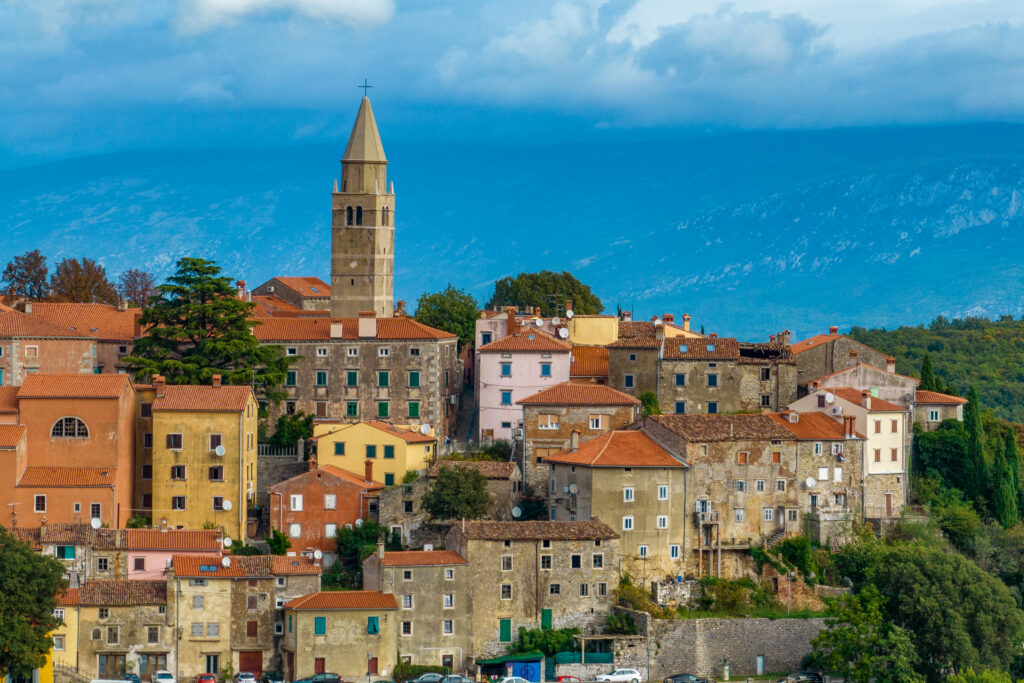
Synopsis
“Crveni i crni” was filmed in and around Labin, in Tito Square, People’s Museum, San Marco Promenade and Gora Glušići, where the mining complex Vinež was reconstructed. The film is a history drama about Labin Republic, the first anti-fascist uprising in Europe, during which the miners of different nationalities stood against fascist repression and capitalistic exploitation. It features workers’ solidarity and resistance. The movie poster by Mirko Ilić became one of the most famous Croatian movie posters.
details
Original title: Crveni i crni
Year: 1985
Country of production: Yugoslavia
Production: Jadran film
Genre: drama, history
Directed by: Miroslav Mikuljan
Starring: Bekim Fehmiu, Milan Štrljić, Olivera Ježina, Radko Polič, Miodrag Krstović, Boris Kralj, Igor Galo, Fabijan Šovagović, Bogoljub Petrović, Ivan Bekjarev, Krunoslav Šarić, Stevo Žigon
Filming locations in Istria: Labin
REVIEW
CRVENI I CRNI, directed by Miroslav Mikuljan, 1985
“KOVA JE NAŠA!”
In 1985, when Yugoslavia begins to slowly fall apart and the working noise of factory plants increasingly turns into cries of protest and rebellion, Miroslav Mikuljan’s “Red and Black” went almost unnoticed. Produced by Jadran film, it tells the story of an uprising of Labin mine workers in March 1921, and their resistance to the fascists and capitalist exploitation. Labin Republic is a brief moment in which Labin citizens, tired of oppression, exploitation and poverty, said “NO”. They took over the mines, organized the production, founded “red watches”, created their own miniature order and something that resembled freedom, but were soon conquered and humiliated both in their homes and at work. In that context, the film brings many details at once, but in an attempt to paint a wider picture, the perspective was poorly executed.
According to the Croatian historiography, the uprising of about 2,000 mine workers is considered one of the first uprisings against fascism in history. Although the subject matter and basic premise of the film is one of the mythical events from the history of the Istrian peninsula, and the film features valuable native values of the Labin region and Istria, such as traditional clothing and costumes, instruments such as the “roženica” and the Istrian “mih”, singing “na tanko i debelo”, and dancing the “balun” in an Istrian tavern, in which the scenography elements are excellently executed and as such very authentic, this film is only trying to sing an ode to the fight. For all those who do not know much about the Labin uprising, this film is useful in the context of a screen adaptation of something which happened in Istria more than a hundred years ago and, as such, forms an important part of the topos and shaped numerous further narratives, ideals and efforts of Istrian residents to this day. The shout from the title is based on an impressive scene of worker’s gathering in the main Old Town square.
The overemphasized tendentiousness and focused ideological specificity dramaturgically overshadowed the pain and fragility of the fate of workers and peasants in their homeland, which has become the Kingdom of Italy, and that is mainly at stake here. Numerous errors regarding language, pronunciation and accents largely stifled the poetics of Istrian motifs, so those elements seem disconnected and more posed than part of the historical reality. The film seems as a wasted shot, because the victim is already dead, like a tired song with no breath.
Despite the fact that it depicts events in detail (with certain errors in historical interpretation), which can be largely attributed to the high production budget for that era, it can be concluded that history here is not interpreted artistically or analysed factually, but is used like cannon fodder for the occasions and upcoming ideological struggles from the time the film was made. All the power of methodical school examples arranged in a narrative template, for example: the melancholic miner Ivo loves the widow Marija, while the revolutionary trade unionist, the gullible Pipan, loves the people, but they fail to depict the most important feelings that the narrative should evoke - defeat and loss of dignity, gathering up the fragments of one’s own self because of great and important politics, lack of justice and loss of trust.
With very famous actors in the film world of the time such as Bekim Fehmiu, Fabijan Šovagović, Ivo Gregurević, Milan Štrljić and Semka Sokolović Bertok as young artists, and with the participation of the local population and the beautiful view of old Labin, the mine and the surrounding area, it gathered enough media coverage to solidly establish itself and fulfil its ideological function, but its duration and resonance did not last. More frequently mentioned and popular, much more vibrant part of the artistic space of this film is the award-winning poster, made by one of Croatian most famous designers in diaspora, Mirko Ilić, which was exhibited in the New York’s MoMA.
“Crveni i crni” hoped to celebrate history, but it remained captured in the part of the history which it fails to fully understand, missing the undermining premise of dealing with the subject matter in a historical and socio-political context, nor within the viewpoint of each individual touched by the story. Its poetics are exhausted, and its predictable pathos is full of clichés. It presented the fight as a backdrop, perfectly divided into red and black: the rebellious mine workers and their oppressors, falsely depicting it that the power of the world and political forces can fit into two colours, but it failed to depict the spirit of fight, and the complexity of historical facts remained under the surface.
Therefore, “Crveni i crni” remains a lavish, but propagandistic postcard of a workers’ epopee reduced to rhetorical decoration. Artistically, it is very opportunistic with too many “perfect matches”, and as such, very impressive, but at the same time, full of political clichés. It doesn’t celebrate rebellion, but conserves it. It fails open the space for a dialogue with the history, but places it in an imposing formula. Behind this rigid image remains the eerie emptiness of the rhetorical question: why are workers’ voices not heard neither in history nor on film?









